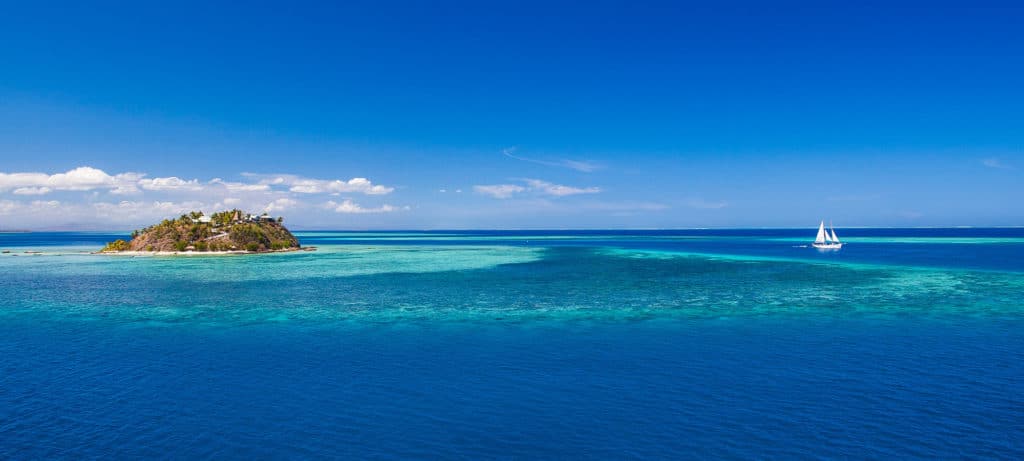
The gray dawn came reluctantly, with occasional drizzle that at times became torrential rain as increasingly heavy squall lines passed through. We’d left Niuatoputapu, Tonga, four days earlier aboard our Flying Dutchman 50, Small World II, and the leading edge of the cold front we had been racing ever since was finally over us. For several hours, we’d been plowing through intensifying squalls under triple reefed main, staysail and reefed yankee. Just ahead lay our destination, Savusavu Bay, on the south coast of Vanua Levu, the second-largest isle in the nation of Fiji. It had been an interesting trip. What had started out as a fairly boisterous passage with 20 to 25 knots of wind and 6- to 9-foot seas ad mellowed to an easy broad reach in around 15-18 knots for most of the next two days. But conditions changed as we closed in on Fiji. At midmorning on our final full day out, as we skidded past several low atolls while entering Fijian waters, we watched somewhat apprehensively for the rapid wind shift expected behind a strong frontal line that was approaching us from the southwest; with each successive download of the GRIB files, it drew closer. By around midnight of the final night out, as the wind lighten with the approaching trough, we actually reverted to motorsailing. At about 0200, the shift came, and with it the squalls began in earnest. Luckily, the wind shift to the southwest happened gradually, so we were able to lay a course, with a few degrees to spare, past the heavy breakers of the menacing barrier reef to clear the entrance to Savusavu Harbor.
As we entered Savusavu’s narrow channel, we saw cruising yachts from all over the world anchored and moored along the straggling, somewhat dilapidated waterfront of the small, bustling city. Steam rose from the muddy banks, attesting to the prevalent volcanic activity in the region. The waters were murky from the runoff of many rivers and streams — a marked contrast to the crystal-clear waters of the islands and atolls of the central Pacific, where we had been cruising for the previous two years.
Miraculously, by the time we had anchored and contacted the port officials on the VHF, the skies had begun to clear. Shortly after, a boat came alongside with the officers from health, immigration and customs. After a perfunctory fumigating of Small World to eliminate any mosquitoes we might have brought from Tonga, we were warmly greeted and welcomed to Fiji. Clearance was simple and straightforward, with a trip ashore later to finish the process. By midday we had moved farther into the harbor and picked up a mooring ball off the Waitui Marina.
To understand the dynamics of cruising Fiji, it is first important to note the region’s geography as well as its history. With more than 300 islands, by some estimates, and countless reefs and shoals (many of which are poorly charted), for centuries the Fijian archipelago has been a feared and often avoided area for shipping.
Dutch explorer Abel Tasman first sighted the islands in 1643, but it was another hundred years before Capt. James Cook briefly went ashore on one of the eastern outlying islands. Then, in 1789, Capt. William Bligh of HMS Bounty, having been set adrift in a small boat with 18 of his loyal crew, successfully navigated and began charting the archipelago’s interior waters.
Ostensibly en route westward toward Batavia, in the Dutch East Indies (where Jakarta sits today), Bligh had unknowingly chosen a course that took him through the often hazardous Somosomo Strait, between the rugged and lush island of Vanua Levu to the north and the larger, mountainous main island of Viti Levu to the south. To this day, the treacherous, reef-strewn area bears the name Bligh Water. Although it is possible to safely transit the strait in benign conditions, when the trade winds rise above 25 knots, the Venturi effect between the two islands, combined with the strong currents that flow through the passage, can create challenging sea conditions for smaller vessels. Forty to 50 knots of wind and steep, short 8- to 10-foot seas are not unusual.
Entering the island group along a course similar to ours, Bligh doubtlessly would have passed several enticing-looking landfalls. But it was well known that cannibals inhabited these islands, and so Bligh wisely avoided going ashore. Instead he sailed through what is today still some of the most difficult navigation in the entire South Pacific.
Although cannibalism has not been openly practiced in Fiji since the late 19th century, it is an important and undeniable part of the islanders’ heritage. Fiji’s most famous cannibal, Ratu Udre Udre, was finally laid to rest in 1840 after he had consumed, according to the Guinness Book of World Records, 872 people. We found the tomb and shrine to this man on the shore near Rakiraki, which attests to the reverence with which at least some Fijians still hold this barbaric custom from the not-too-distant past.
A much less threatening custom that is still widely practiced is the ceremony known as sevusevu, wherein the powdered root of the yagona pepper plant is mixed with water to become kava, a drink that’s shared communally while drinkers sit in a circle. Kava is consumed almost daily by many Fijians in a ritual that’s an important part of the traditional Fijian culture and lifestyle. Before leaving the town of Savusavu, we stocked up on the yagona root to use for gaining introduction to the village chiefs of the various islands we intended to visit.
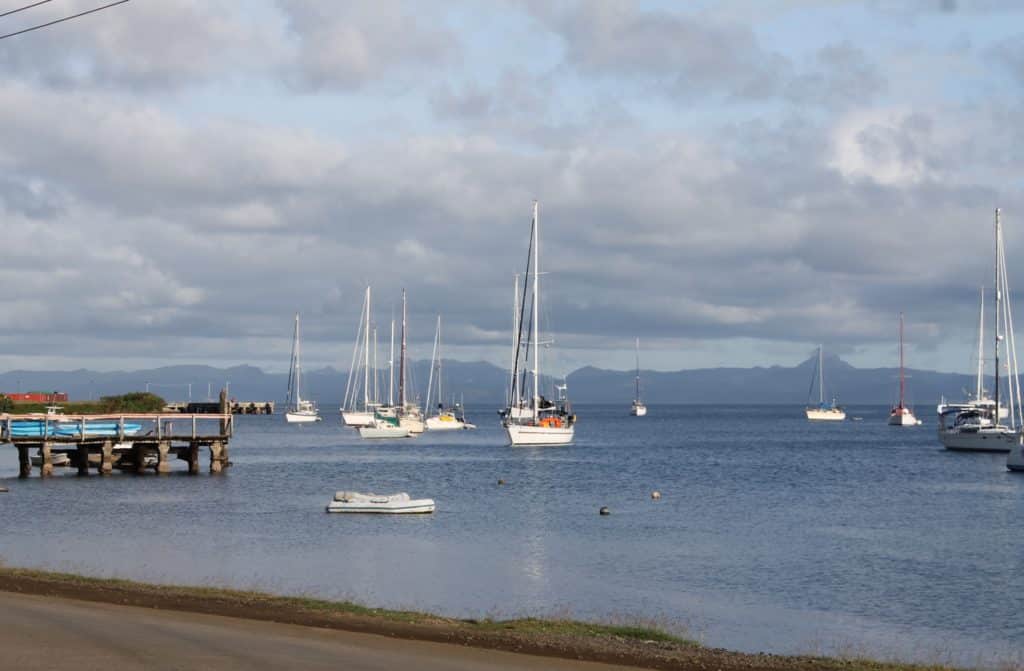
While in Vanua Levu, we rented a car and set off on land adventures. To the south we discovered verdant lowlands with winding rivers, while the semiarid northern plains were filled with extensive sugar cane plantations. The scenery was breathtaking. Looking out across the fields and seeing large groups of men and women using machetes to harvest the cane, we felt as if we were back in the 19th century. Narrow-gauge railway trains are still used to harvest sugar cane, one of Fiji’s most important crops. The tracks meandered across the rolling hills and wound along and over slow-moving rivers where children swam and cows bathed. Men sat on bridges smoking as the long trains moved across a landscape that was romantic and exotic.
Traveling farther east, the roads deteriorated but led to some remote coves and headlands that revealed pristine reefs with a huge diversity of coral. The mind-boggling proliferation of marine life we saw while snorkeling was quite a contrast to some of the fished-out places we’d observed in the eastern Pacific.
Fishing is so good in Fiji that when we made our initial landfall, we put out a line and immediately caught a 23-pound yellowfin tuna. Our luck held nearly every time we fished thereafter, with almost instant success landing mahimahi or tuna. We began to wonder if even a bare hook might produce results while trolling in the deep channels between the islands.
Leaving Vanua Levu, we made a relatively short passage to the nearby island of Namena, where my fiancée, Gayle, her daughter, Sarah, and her friend Adrian, who were crewing for us, wanted to do some scuba diving. Although the island was enclosed within a barrier reef system that gave the impression that it could offer some protection from northeast winds, we spent a very uncomfortable night bouncing about in a 4-foot chop. The island was nearly deserted and quite beautiful, and by the next morning the winds had eased and clocked to the southeast. This made for a leisurely but fairly long daysail down to the well-protected harbor off the island of Makogai.
Makogai is one of the largest of the outlying islands off of Viti Levu’s east coast. The site of a leper colony for almost a hundred years, the once-deserted ruins are gradually being brought back to usefulness as the headquarters for a sea turtle nursery and giant clam sanctuary. We were the only boat in the anchorage, so we went ashore to ask the village chief for permission to stay there.
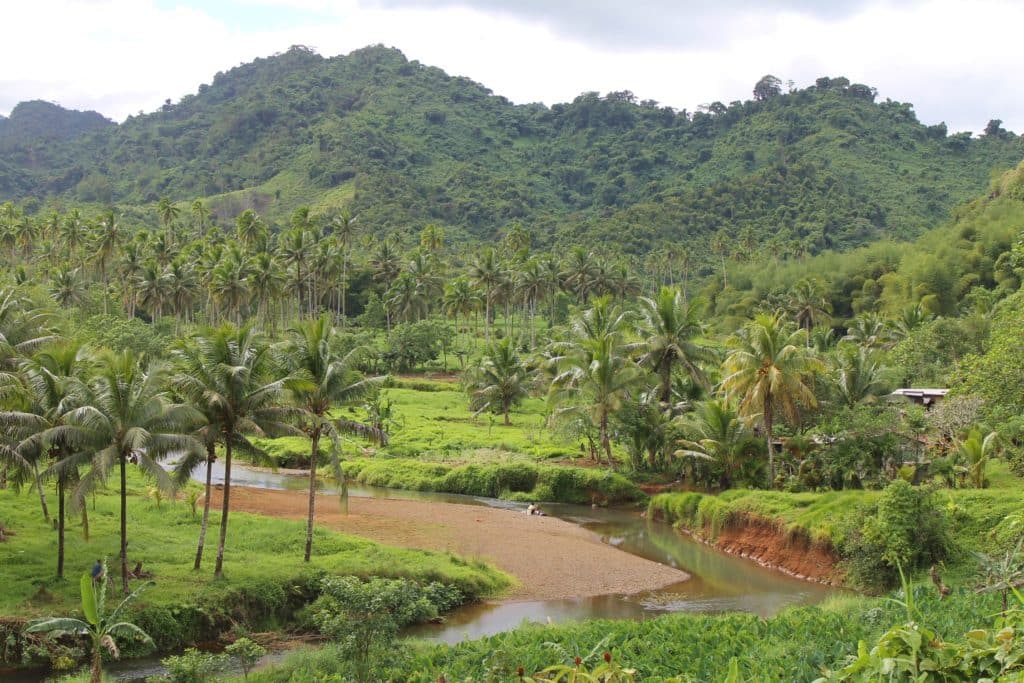
Because Fiji is a former British colony, most of the locals speak English well. We were soon met by a young man who called himself the village spokesman, and he agreed to introduce us to the village chief. Our gift of yagona root was accepted, and so, having been granted full access to the village, we spent the next couple of days hiking around the nearby hills and climbing through the leper colony’s ruins. A long dinghy ride and snorkeling expedition took us to one of the smaller nearby islands; once again, the rich sea life was incredible. Giant clams were virtually everywhere in the deeper water. Some were as large as bold Sarah, who dived down, swam right up to their open jaws, and peered inside.
With the continuing spell of calm weather, we took the opportunity to motorsail over to the old, frontierlike seaport of Levuka, on the island of Ovalau, a day’s sail across the Koro Sea. Situated on the windward side of the island with only an awash barrier reef to protect it from the easterly wave trains, the port was initially chosen for this site because square riggers could sail in, find a reasonable anchorage off the town, and then escape by sailing either north or south a couple of miles to large gaps in the reef. This allowed the ships to make their way off the lee shore of the big island of Viti Levu, to the west. Ovalau, because it is a good distance off Viti Levu, also offered a level of protection from raiding parties in those lawless days of the early 19th century. The town still looks much as it did back then, with many historic structures having been preserved or restored.
Having thoroughly enjoyed our brief stay on Ovalau, we sailed back out into the Koro Sea, still undecided about our next port of call. Under spinnaker and main, we headed south along the coast in light winds that gradually increased and shifted more to the east. Turning to the west, we decided to stop in at the port of Suva, Fiji’s main port and largest city.
With an election only a few days away, we’d been warned by several longtime cruisers that we should stay away from bustling Suva until things settled down. Fiji gained independence from Britain in 1970, but since 1987, the duly elected governments have been overthrown by coups four times. The most recent of these occurred in 2006. We’d been told that random violence directed toward foreigners might result if people weren’t happy with the election results.
Choosing a good place to anchor in the somewhat crowded commercial harbor took a little searching, but ultimately we found a nice spot in 20 feet of water, an easy dinghy ride away from the Royal Suva Yacht Club. Once ashore, we learned that for a nominal fee, we could become temporary members of the club and use the facilities, which included a restaurant, bar and nearby showers. The club’s location, on the main road to downtown, also made it easy to catch a bus or taxi into the central part of the city.
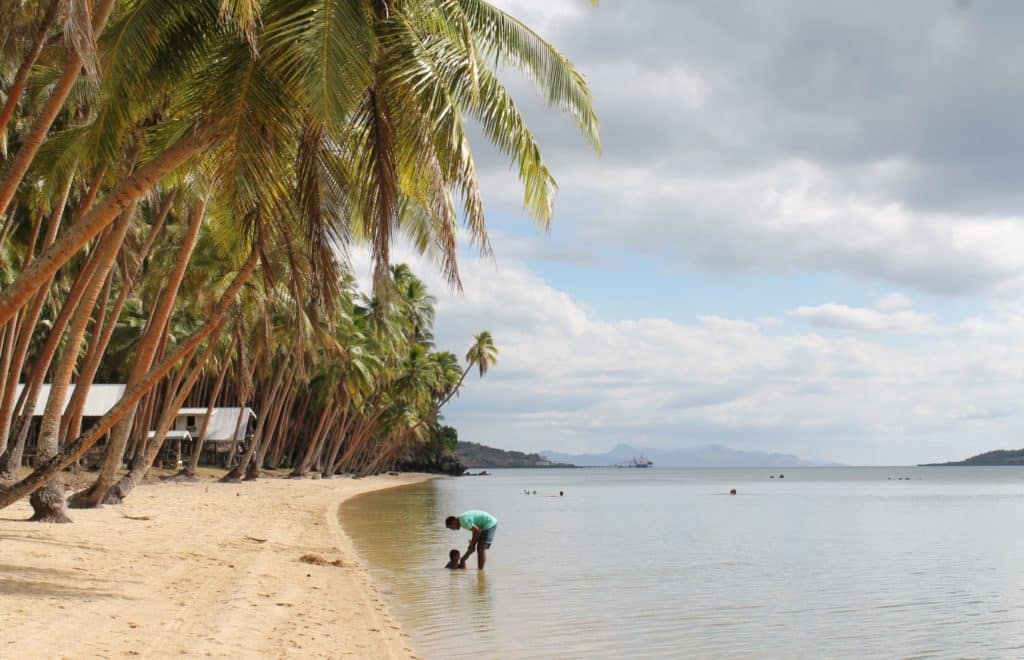
Suva is a crucial center of commerce for the entire southwest Pacific. Hundreds of commercial ships from all over the world converge on the port each year. We found the city to have an unhurried but decidedly cosmopolitan feel. Interesting shops and restaurants abound, and we were able to find computer repairs, marine supplies and a great open-air market, where fresh fruit and vegetables could be purchased at what seemed to us to be incredibly low prices. Gayle was often able to fill two large grocery bags in the market for about $20 in Fijian currency, or $10 USD.
After a few days in the big city, we sailed southwest to a nearby mountainous island called Beqa. The isle is the top of an eroded but rugged and somewhat precipitous volcanic crater with one side blown out, so a yacht can sail well up inside into perfectly sheltered waters. Entering through a barrier reef, we skirted along the eastern coast and then set a course to enter the breathtakingly beautiful, steeply wooded channel leading into the depths of the harbor. About a mile in, we found a spot in 40 feet of water and dropped the hook, surrounded by the stark, natural beauty of a quintessential South Seas paradise.
There was a small village ashore near the mouth of the bay; after offering our bundle of yagona, we were warmly greeted by the chief and his wife, who were also hosting one of Fiji’s more popular singing groups. We were invited into the chief’s house, where a large, intricately carved bowl of kava was brought out, and we spent the next several hours getting to know our hosts, laughing and dancing.
Following several days exploring beautiful Beqa, we returned to Viti Levu and sought out an anchorage called the Bay of Islands, which is located between several small isles directly across from Suva’s large harbor. The well-protected anchorage featured free moorings, but we chose to drop the hook in the firm mud bottom. We left the boat there for a few days while we rented a car and explored ashore. As we drove along the eastern flank, we marveled at the broad, slow-moving rivers and brand-new highway that traversed valleys and wound over rolling hills. We eventually made our way around the somewhat desolate north shore to the sheltered west coast.
During this time the national elections took place, and yet, everywhere we went, we were greeted with smiles and waves and never felt even remotely threatened. In fact, the one thing we’ll always remember Fiji for is its friendly people. Everywhere we went, we were greeted with “Bula!” — which basically means “hello, friend,” “welcome” and “good day” all at the same time. If you are being greeted really effusively, you might hear “bulabula” or even “bulabulabula.”
For Sarah and Adrian, time was running short, so off they went to the airport and a flight home. Gayle and I continued west, gunkholing the reef anchorages along Viti Levu’s south coast before spending almost a month in the western islands, beachcombing, snorkeling and hiking. Our two months in Fiji had gone by all too quickly, and it is with wistful thoughts that we remember our wonderful adventures in such a friendly, unique and beautiful place in our small world.
Following his cruise to Fiji, Todd Duff hauled Small World II there and eventually sold it to a Canadian cruiser. After returning to the British Virgin Islands, he resumed his career as a yacht broker, and has purchased an Amel Super Maramu, aboard which he and his fiancée, Gayle Suhich, are looking forward to new adventures.
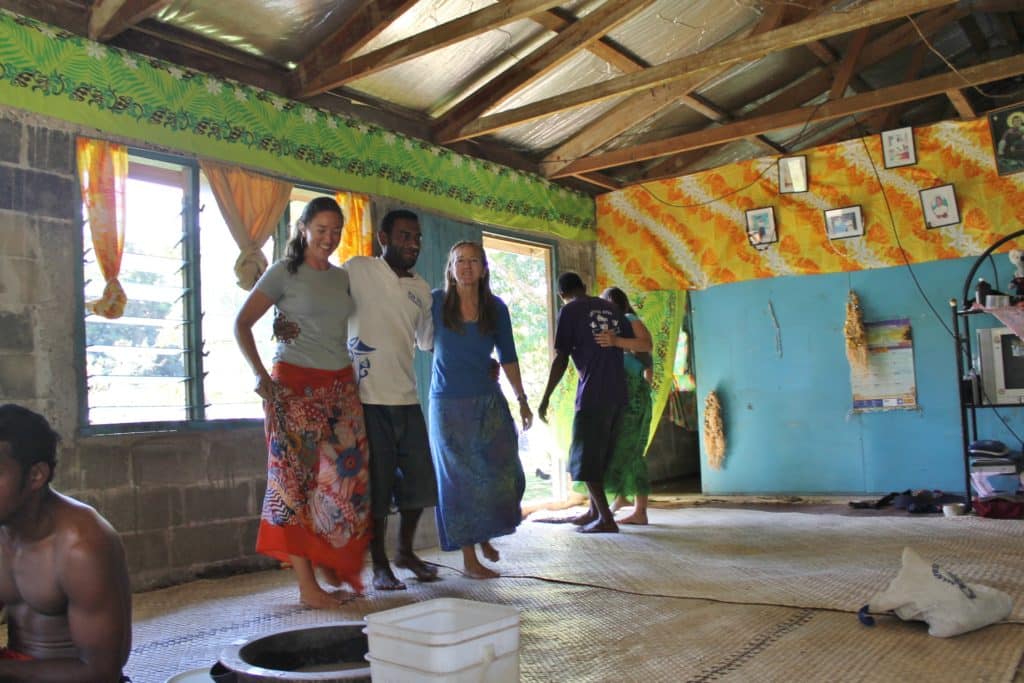
What to Know If You Go
While Fiji is not necessarily on the direct path across the Pacific, on what is sometimes referred to as the Coconut Milk Run, many cruisers elect to sail northwest from Tonga, or come up from New Zealand and make Fiji their stop on the way toward Vanuatu and/or the Torres Strait. Still others stay in the region for years, sailing triangles from New Zealand to Tonga to Fiji and back.
Shopping in Fiji is a refreshing break for the cruising kitty. After the exorbitant prices of French Polynesia and the Cook Islands, we found Fiji very affordable. Gayle regularly stocked up on food for an entire week for the equivalent of about $20 USD. All visiting yachts arriving in Fiji are subject to an 18-month limit on their stay; after that, they’re subject to a 15 percent import duty. For that reason, most cruisers who decide to make Fiji a semipermanent base for a few years will sail up to Futuna Island, about 300 miles north of Vanua Levu, once a year.
Although Fiji is in the heart of the South Pacific cyclone belt, there are innumerable decent hurricane holes, and excellent shelter is provided by Vuda Marina in cyclone pits. Many cruisers do in fact base their boats in Fijian waters for extended periods of time. Immigration allows for a four-month visa upon sailing into the country; it can be easily extended for up to six months. Further extensions require a visit to the immigration department and a legitimate reason for staying, which can range from doing work on the boat to writing a story about Fiji; it just needs to be valid and compelling.








